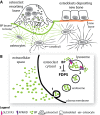From vesicle to cytosol
- PMID: 29947329
- PMCID: PMC6021168
- DOI: 10.7554/eLife.38847
From vesicle to cytosol
Abstract
Drugs called bisphosphonates are used to treat a range of bone diseases, but how do they reach the enzymes that are their target?
Keywords: biochemistry; bone-targeting drugs; cell biology; chemical biology; genome-wide screening; human; lysosomes; mechanism of action; membrane transporter; mouse.
© 2018, Rogers et al.
Conflict of interest statement
MR, MM No competing interests declared
Figures

Comment on
-
Identification of a transporter complex responsible for the cytosolic entry of nitrogen-containing bisphosphonates.Elife. 2018 May 10;7:e36620. doi: 10.7554/eLife.36620. Elife. 2018. PMID: 29745899 Free PMC article.
References
-
- Dunford JE, Thompson K, Coxon FP, Luckman SP, Hahn FM, Poulter CD, Ebetino FH, Rogers MJ. Structure-activity relationships for inhibition of farnesyl diphosphate synthase in vitro and inhibition of bone resorption in vivo by nitrogen-containing bisphosphonates. Journal of Pharmacology and Experimental Therapeutics. 2001;296:235–242. - PubMed
Publication types
MeSH terms
Substances
LinkOut - more resources
Full Text Sources
Other Literature Sources

